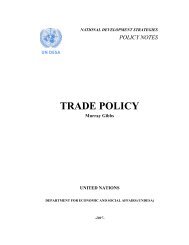16th Meeting of Senior Fellowships Officers of the ... - Development
16th Meeting of Senior Fellowships Officers of the ... - Development
16th Meeting of Senior Fellowships Officers of the ... - Development
Create successful ePaper yourself
Turn your PDF publications into a flip-book with our unique Google optimized e-Paper software.
Operational Issues 15<br />
and long-term objective which could only be materialized with <strong>the</strong> continuing support<br />
<strong>of</strong> both <strong>the</strong> national placement and supervising agencies and <strong>the</strong> fellows. A Quality Assurance<br />
System still needed to be conceptualized and fine-tuned. During <strong>the</strong> period under<br />
review agencies such as IAEA, <strong>the</strong> World Bank, ITTO and WHO had conducted<br />
surveys or evaluations and had come up with some findings and parameters which could<br />
be used as benchmarks toward <strong>the</strong> ultimate goal <strong>of</strong> a Quality Assurance System. Quality<br />
assurance models used similar key methodologies such as self-evaluation, peer review,<br />
performance indicators and quality audit. Such methodologies were also used in <strong>the</strong><br />
evaluation process by United Nations system agencies even though a common quality<br />
assurance model still remained a project in <strong>the</strong> making. In <strong>the</strong> age <strong>of</strong> globalization, <strong>the</strong>re<br />
was a gradual convergence <strong>of</strong> <strong>the</strong> international quality assurance systems, which mirrored<br />
in essence <strong>the</strong> intertwined nature <strong>of</strong> world educational systems. Apart from that global<br />
trend, <strong>the</strong> international dimension <strong>of</strong> education was also gaining ground in <strong>the</strong> national<br />
and institutional quality assurance systems, even though quality assurance approached in<br />
many countries <strong>of</strong> <strong>the</strong> developed world were still too much confined to national contexts.<br />
In <strong>the</strong> United Nations system context, <strong>the</strong> approach would have its own peculiarities and<br />
variations. It would entail such functions as commitment to continuous learning and<br />
research; accountability; client orientation, market transparency, planning and resources.<br />
The first function – learning–was focused on <strong>the</strong> personal level <strong>of</strong> <strong>the</strong> trainees whereas<br />
<strong>the</strong> rest were centered on <strong>the</strong> external responsibilities <strong>of</strong> <strong>the</strong> UN agencies in relation to<br />
governments, donors and o<strong>the</strong>r stakeholders. A working group would be required to<br />
elaborate and come up with a draft inter-agency Quality Assurance Policy.<br />
Recommendation 4:<br />
Training Institutions Should Be Encouraged to Establish Mechanisms for Evaluation <strong>of</strong><br />
<strong>the</strong>ir <strong>Fellowships</strong> and Training Programmes.<br />
57. Mr. Rudi reminded <strong>the</strong> participants that <strong>the</strong> 15th <strong>Meeting</strong> had expressed <strong>the</strong> desire for<br />
UN agencies to encourage training institutions to establish mechanisms for evaluation <strong>of</strong><br />
<strong>the</strong>ir training programmes. That required <strong>the</strong> monitoring <strong>of</strong> <strong>the</strong> programmes, <strong>the</strong> progress<br />
<strong>of</strong> <strong>the</strong> fellows and <strong>the</strong> reporting to <strong>the</strong> agencies concerned. The Focal Point had<br />
sought <strong>the</strong> advice <strong>of</strong> some national placement and supervising agencies on <strong>the</strong> evaluation<br />
systems, which <strong>the</strong> training institutions in <strong>the</strong>ir home countries had in place. In<br />
<strong>the</strong> Ne<strong>the</strong>rlands, for example, all <strong>the</strong> high education institutions had an internal system<br />
<strong>of</strong> evaluating <strong>the</strong>ir standard, national and international study programmes. They were<br />
also subject to international benchmarking organized every four years. As to <strong>the</strong> tailormade<br />
programmes, it was presumed that <strong>the</strong>y might have ei<strong>the</strong>r a standardized or an ad<br />
hoc evaluating system. The Ne<strong>the</strong>rlands Organization for International Cooperation in<br />
Higher Education (NUFFIC) provided <strong>the</strong> training institutions with monitoring and<br />
evaluation formats for programmes funded by or through it. NUFFIC was also ready to<br />
evaluate <strong>the</strong> courses or training programmes <strong>of</strong> <strong>the</strong> UN fellows, if requested by <strong>the</strong> UN<br />
agencies. In Canada, <strong>the</strong> Canadian Bureau for International Education (CBIE) provided<br />
<strong>the</strong> fellows with an information kit which included, among o<strong>the</strong>rs, two evaluation forms

















